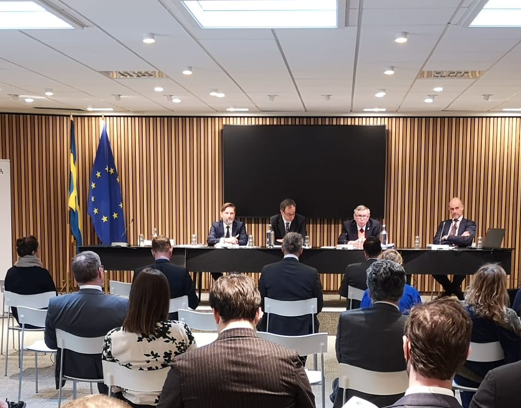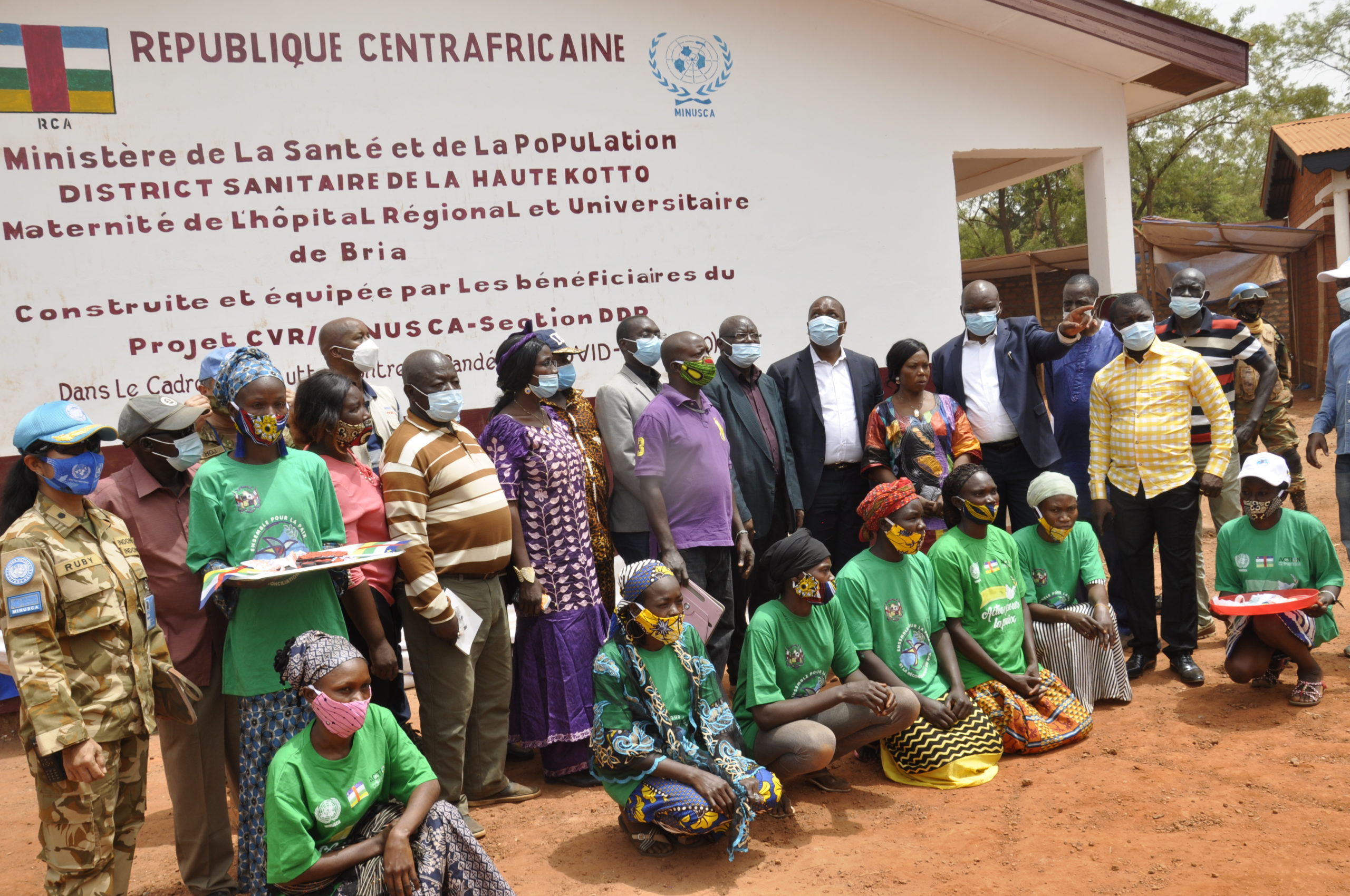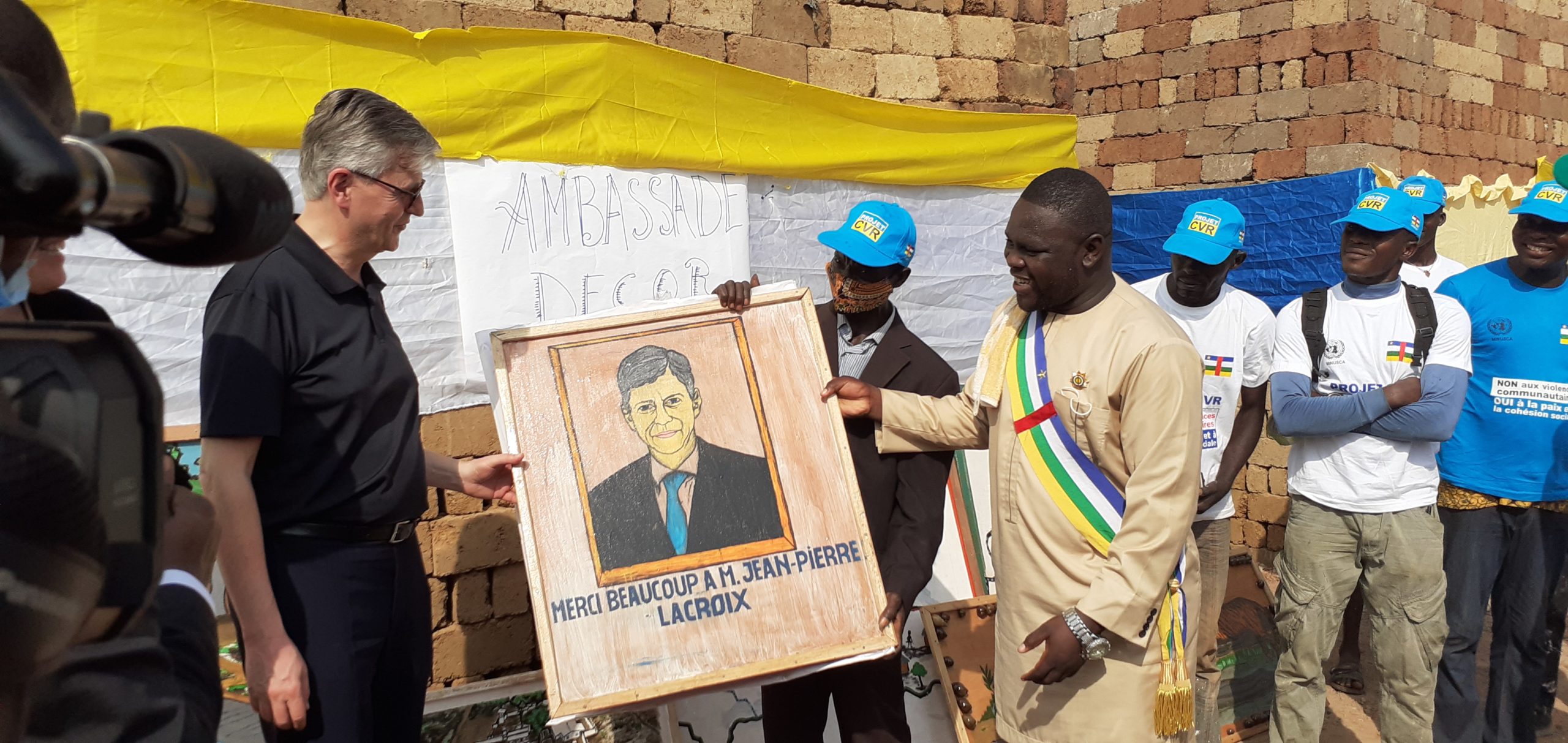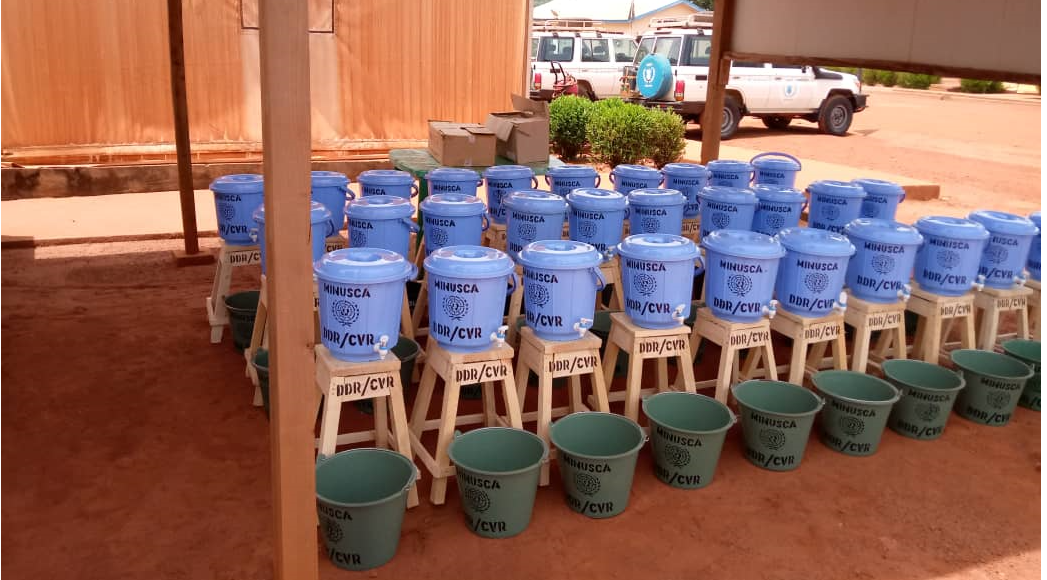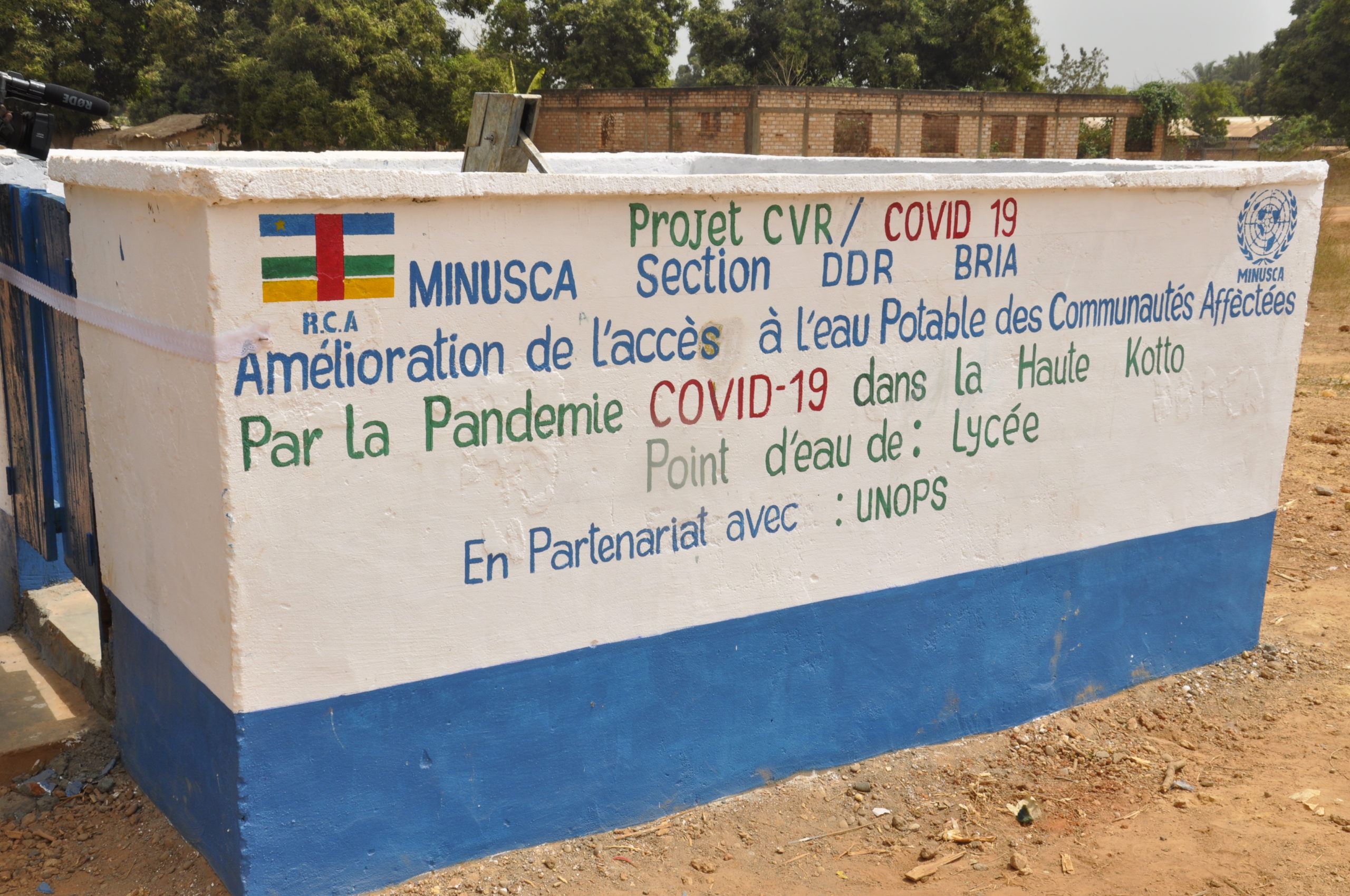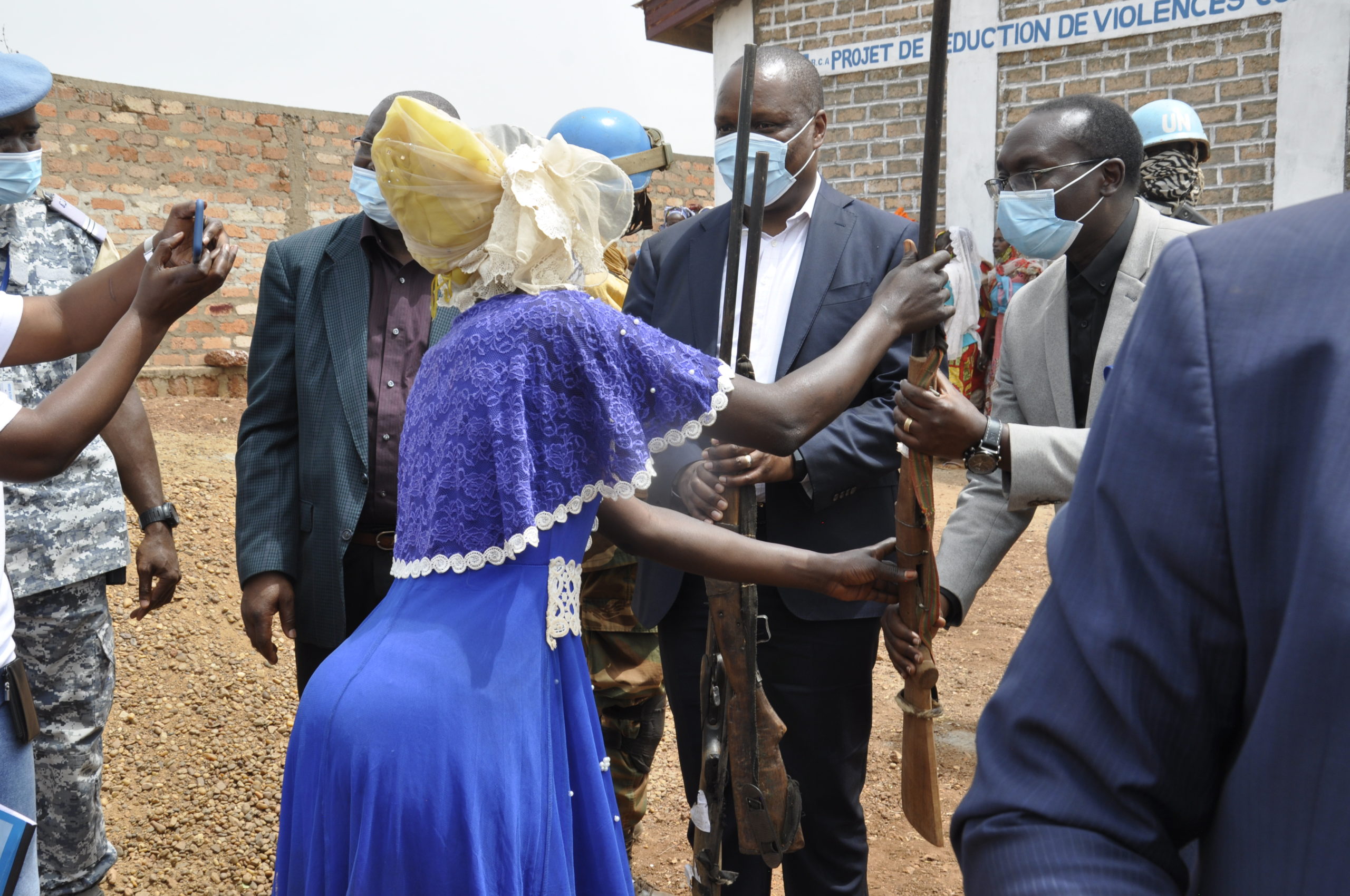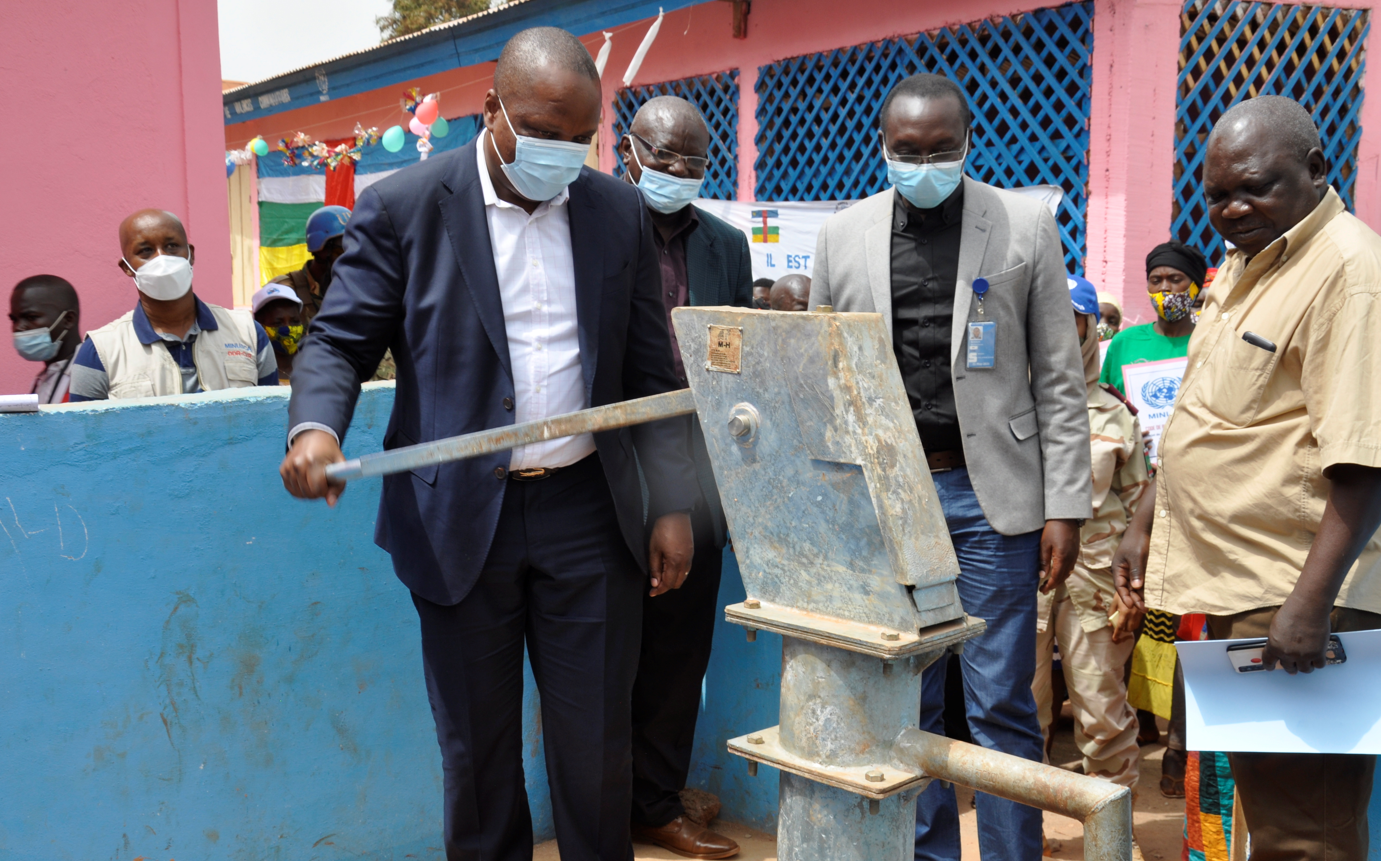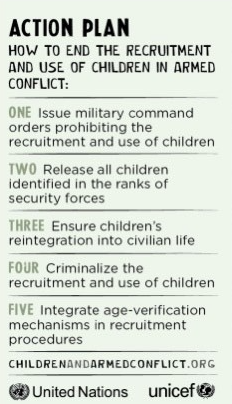CONTENTS
IN FOCUS:
EUROPEAN UNION
4.
FIELD UPDATES
1.
STORIES FROM THE FIELD
5.
IDDRS UPDATES
2.
DISCOVER OUR MISSIONS
6.
RECENT PUBLICATIONS
3.
GUEST FEATURE
7.
UPCOMING
HIGHLIGHTS FROM THIS NEWSLETTER ISSUE
BY DPO-DDR SECTION
 IOM Somalia and UNSOM believe that the role of Somali women is vital in creating the necessary conditions to nurture reconciliation and to achieving the desired sustainability goals.
IOM Somalia and UNSOM believe that the role of Somali women is vital in creating the necessary conditions to nurture reconciliation and to achieving the desired sustainability goals.
Lucky Omaar
Project Officer, International Organization for Migration (IOM) – Somalia
IN FOCUS: EUROPEAN UNION
A successful integrated DDR process aims to support the transformation of individuals from combatants to civilians and of societies from conflict to peace. As such, these complex changes can only be achieved and brought about through concerted and well-coordinated efforts undertaken by a range of local, national, regional and international actors working in partnership to achieve a common goal — sustainable peace. Over the past decades, conflict has evolved bringing with it new challenges for DDR practitioners. In response, DDR practitioners have developed not only new tools, but also new partnerships to meet the demands of a shifting operational landscape.
To this end, a core mandate of the DDR Section is to foster, maintain, and expand strategic partnerships at global level as well as support their operationalization in field settings. Against this backdrop, this section would highlight the partnership the DDR Section maintains with the European Union.
TOWARDS A REVISED EU DDR POLICY
The European Union (EU) has engaged in and supported a range of DDR processes around the globe: Through the Aceh Monitoring Mission in Indonesia, as a convening actor in Nigeria, and as a financier in Colombia. These engagements have been guided by the 2006 EU Concept on DDR, and in the same way as contemporary conflict dynamics called for the revision of the UN Integrated DDR Standards (IDDRS), they challenged the way in which the EU works with peacebuilding in general and engages in DDR in particular. Conflicts see the proliferation of armed groups, protracted and reccurring violence across international borders, active presence of organized criminal gangs and terrorist-designated organizations, and peace agreements are increasingly rare or broken, calling for the need to update the 2006 Concept on DDR to better reflect the realities of today’s conflicts.
In addition to the challenges in the settings where the EU engages in peacebuilding, the EU institutions have seen significant changes since 2006. In particular, the Treaty of Lisbon came into effect in 2009 and with it, the creation of the position of High Representative of the Union for Foreign Affairs and Security Policy as well the EU diplomatic corps – the European External Action Service (EEAS). With these developments and the establishment of the EU Common Security and Defense Policy (CSDP) in the same year, the EU’s engagement in peacebuilding efforts developed further. Fast-forwarding to 2018, the EU adopted the Integrated Approach to External Conflicts and Crises. This provides an overarching framework for all EU peacebuilding engagements, and in short states that the EU should make use of its entire peacebuilding toolbox across the peace continuum, in close partnership with local, national, regional and international partners.
These internal changes had an influence on the way in which the EU works with DDR. To reflect these, the EEAS and the European Commission embarked on a joint ambition to develop a Joint Communication outlining the EU’s approach to DDR. The revision of the policy required a very wide range of expertise, and the process of developing the Joint Communication involved over 20 different services from the EU Commission and from within the EEAS. Furthermore, it drew on lessons from the UN’s revision of the IDDRS, on expertise from EU’s member states, independent experts, and the civil society.
The Joint Communication was adopted in late 2021 and connects EU’s DDR engagements to the Integrated Approach. This enables the EU to engage and support DDR processes at all stages of conflict and adapt the support and type of engagement depending on the local contexts. For instance, the EU can contribute with DDR expertise in negotiations, engage through a military or civilian mission, or provide financial support to other partners engaged in a process. Additionally, the Joint Communication ensures a high level of compatibility with the IDDRS, which lays the foundations for enhancing the partnerships between the EU and the UN within the DDR field.
DDR processes take place in increasingly complex and different contexts. As such, the aim of the Joint Communication was not to provide detailed, operational guidance for EU actors on DDR, but rather to lay out the key principles for the EU’s engagement in DDR. These five principles are central to realistic, flexible, and conflict sensitive support to any DDR process:
- Policy driven and coordinated with partners
- Nationally and locally owned
- People-centered and voluntary
- Well planned
- Adaptable
As the Joint Communication is a document by the European Commission and the EEAS, it will be accompanied by Council conclusions, where the EU’s 27 member states will agree to endorse the Joint Communication, emphasize specific aspects of DDR, and to steer the EU’s DDR engagements in certain directions. Once the Council conclusions are adopted in the first semester 2022, they offer a strong political framework that – together with the Joint Communication – makes up the EU’s DDR policy.
In parallel with the council conclusions process, EU is taking the first steps of implementation of the Joint Communication. One important element of these endeavours is the sensitisation of the policy, and as a first step, the EEAS co-organised an event together with the Swedish Permanent Representation to the EU and the Folke Bernadotte Academy at the end of March to explore the translation of policy into practice, and discuss the nexus between conflict sensitive and gender responsive DDR engagements. This event brought together a wide range of expertise from the EU and UN systems, from EU member states, the civil society, and the research community, and lead to a number of interesting conclusions.
STORIES FROM THE FIELD
IOM SOMALIA IN COLLABORATION WITH UNSOM
Female Rehabilitation Programme
Working “tene de tena” in the central african republic
MINUSCA Section DDR and Project CVR
The location is Bria, the Central African Republic (CAR). The project is called Tena de Tena, which means “hand in hand” in Sangho. It has brought together 52 beneficiaries of which 23 women, representing in 80% the anti-balaka and in 20% the ex-Seleka armed movements, hailing from the ethnic groups of Goula (10%), Banda (84%), Sara (5%) and Mbororo (1%), not so long ago involved on the opposing sides of the armed struggle. The group’s leader is Ata Koli (the Sage) formerly a Marabout and the mystical guide of all anti-balaka recruits since 2016.
The ambition of the Tena de Tena group is to become a powerful force in support of sustainable peace and an inspiring engine for economic development in the CAR. The group works in farming, fisheries, brickworks and husbandry on the area of some 2 ha at the shores of the river Samba. Their vision is to convert the Tena de Tena project into a sprawling site, representing both the natural beauty of the Bria area and the success of the collective endeavors for peace.
Tena de Tena is but an example of a larger Community Violence Reduction (CVR) programme supported by the United Nations Multidimensional Integrated Stabilization Mission in the Central African Republic (MINUSCA) that has been supporting, since early 2016, between 4,000 and 6,000 beneficiaries annually, a large percentage of whom are women. The site was visited in February 2022 by the Under-Secretary-General for Peace Operations, Jean-Pierre Lacroix who, expressed his great appreciation to the achievements of these projects in collaboration between MINUSCA and local and national authorities in Bria. He stressed in an interview with local journalists that he had found the impact of CVR encouraging and wished to “do even more”. CVR is implemented as a complement to the National DDR Programme across the CAR and locations, other than Bria, include the capital city of Bangui, Bangassou, Bouar, Bossangoa and Kaga-Bandoro.
CVR: a grassroot proposition
Community Violence Reduction is a tool first used in Haiti in 2006 when the Security Council requested that DDR efforts in the country be reoriented towards CVR. This was the first time the Council requested a grassroots programme targeting armed gangs operating in urban neighborhoods. Since then, the CVR approach has gone global, with CVR programming in six peacekeeping missions: MINUSCA (CAR), MINUSMA (Mali), MINUSTAH (Haiti, now defunct), MONUSCO (DRC), UNAMID (Sudan/Darfur, now defunct) and UNOCI (Cote d’Ivoire, now defunct). In the Central African Republic, it started under the moniker of pre-DDR with an objective of keeping armed groups off the streets during the 2015-16 electoral process. It has grown and gained in importance and local population’s recognition ever since.
Today, the 26-person DDR Section in MINUSCA supports a DDR process that is composed of the Community Violence Reduction as a complement to the mainstream National DDR Programme, launched in December 2018. Meandering between opportunities and challenges, the latter including the electoral violence that accompanied the last year presidential election and resulted in the creation of a brand new armed groups coalition, the Coalition of the Patriots for the Change (CPC), the national DDR Programme has managed to disarm and demobilize, as per the official data for the financial year 2020-21, more than 3,000 combatants, removing from the use more than 2,500 combat weapons, more than a hundred thousand pieces of ammunition and 1,500 explosives of different kinds. The impressive numbers may be a drop in the ocean of needs but a key progress without a doubt.
Bringing people back on the path to dignity and peace
In an editorial with MINUSCA FOCUS magazine issue of August of 2021, dedicated to DDR and CVR, Lizbeth Cullity, the Deputy Special Representative of the UN Secretary-General in MINUSCA wrote that “DDR plays a decisive role for the stability of a country only starting to emerge from an armed conflict and of which large swaths of the territories remain under the control of the armed groups [such as the Central African Republic]. DDR is a tool that ultimately aims to stand down the armed groups so as to lead, progressively, to the restauration and extension of the State authority”. In an interview for the same publication, Samuel Touatena, the Coordinator of the national organization responsible for the implementation of DDR (the Executive Unit for the National DDR Programme, UEPNDDR), reaffirmed that the DDR “contributed to the return of peace to the Central African Republic, while recognizing that we have been confronted with important challenges”.
Beneficiaries, both of DDR and CVR, seem to agree. In the aforementioned interview with local journalists, Mr. Lacroix confirmed that “We hear the requests from the local population to be more present – not less – more present”. Marricka Sandrine Zaguika , mother of three, who was supported to become a seamstress, confided in the MINUSCA FOCUS that “Thanks to the CVR, I have become a businesswoman, an independent person who can cater for the needs of my children; I own a workshop in which I employ two apprentices”. Appreciation also resounds in the voice of Amir Sinousi, father of three, a car mechanic. He says: “Before the eruption of violence in 2013, I was a taxi driver in the city of Bangui. I joined a group of combatants when I had lost my only breadwinning source because of the crisis. As soon as the CVR programme was launched, I joined and chose car mechanics as my preferred profession. Today, I have my own repair shop, make between 30,000 and 40,000 XAF (USD 50-65) per week. A couple of youth from the neighborhood are doing their apprenticeship with me and I am called to help when a car breaks down in several towns around”.
Inclusive versality to timely address challenges
What makes CVR such a universal tool in supporting DDR programmes, is its versatility. It can be easily molded according to the circumstances of the context, can be done before, during, after or, in some cases, instead of DDR and address needs of people not eligible for DDR, youth at risk of recruitment and a large proportion of women residing in communities affected by armed violence. This versality was in plain evidence in the Central African Republic when MINUSCA-supported CVR was converted in 2020 to provide rapid response to the ever-expanding COVID pandemics. For instance, the MINUSCA Bria DDR Section quickly re-adjusted its strategy to maintain its critical support to the CVR beneficiaries and to better respond to the multifaceted needs of local authorities and affected communities. 250 COVID-prevention kits were distributed not only in the city of Bria but along the Bria-Ouadda Djalle axis and to remote villages around Bria. CVR resources were redirected towards the production of face masks (resulting in the final output of 25,650, of which 5,000 were even shipped to the capital city of Bangui as a gesture of solidarity), soap (27,490 bars of 300g each) and various carpentry pieces for local health care units. Beneficiaries learning the trade of construction supported the development of COVID isolation and treatment centers in Bria and neighboring Boungou, a modern maternity ward of 48 beds (as compared to 2-3 beds available for maternity in Bria general hospital to date), allowing thus to separate COVID-affected patients, as well as testing laboratory in Bria (that can conduct testing beyond COVID, for viruses such as HIV or bacteria such as tuberculosis).
Planting seeds for sustained peace
Back to Bria of 2022. Not far from where Tena de Tena operates, the Lasmi site hosts 20 women who used to be associated with armed groups of ex-seleka (95%) and anti-balaka (5%), representing the ethnicities of Rounga (90%), Banda (5%) and Sara (5%). The site offers vocational training in stitch-bonding, bakery, and restaurant-catering. The CVR programme supported the construction of two workshops and a kitchen which go beyond the CVR skill-building activities and offer a space for strengthening social cohesion, fostering mediation and local conflict resolution. A borehole with a water pump was installed to cater for the beneficiaries in the site but also to some 5,000 households in the proximity.
It is hoped that by force of example, similar projects will proliferate throughout the Central African Republic bringing their small but potent contribution to the return of peace across the country.
DISCOVER OUR MISSIONS
INTERACTIVE MAP
You can find more information and highlights from the field in our interactive map below. Engage with the features in the map to explore the DDR mandates in different contexts.
*The boundaries and names shown and the designations used on the maps on this site do not imply official endorsement or acceptance by the United Nations. See Terms of Use.
Field updates
TIMELINE OF FIELD UPDATES
(JANUARY – APRIL 2022)
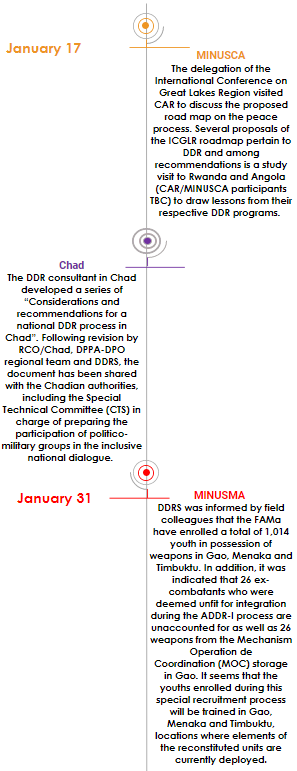
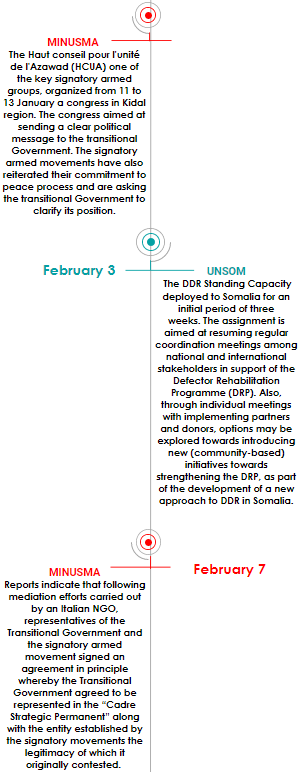
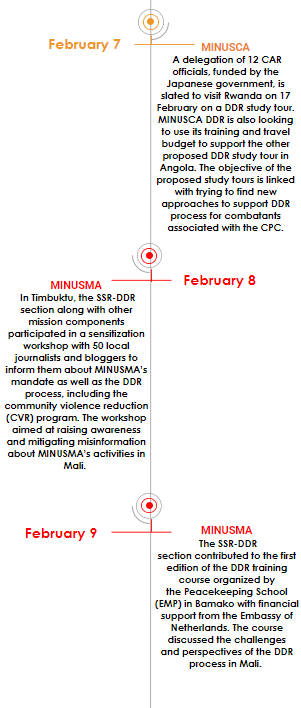
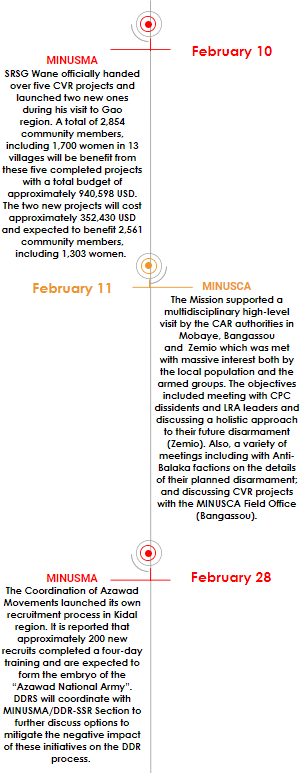
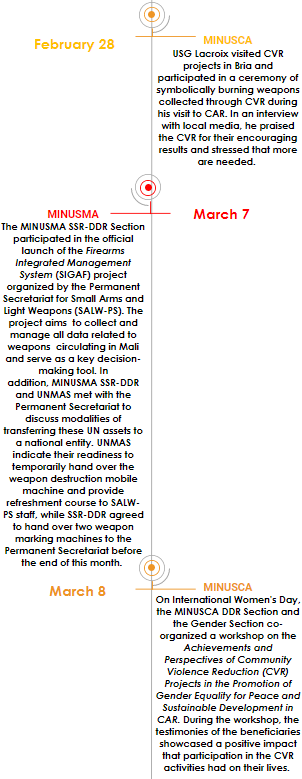
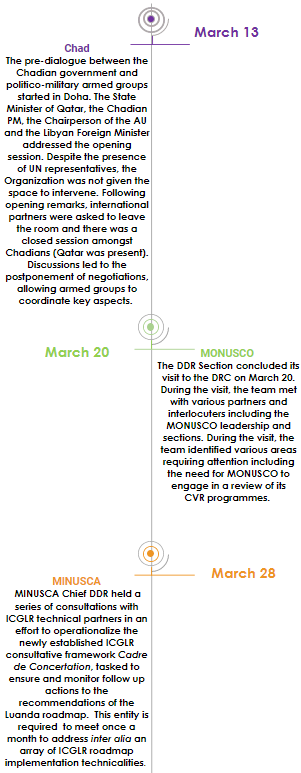
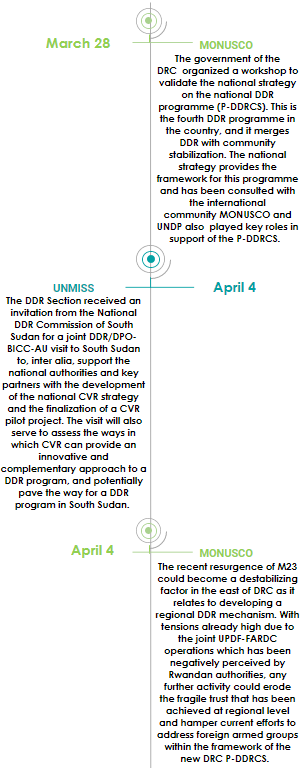
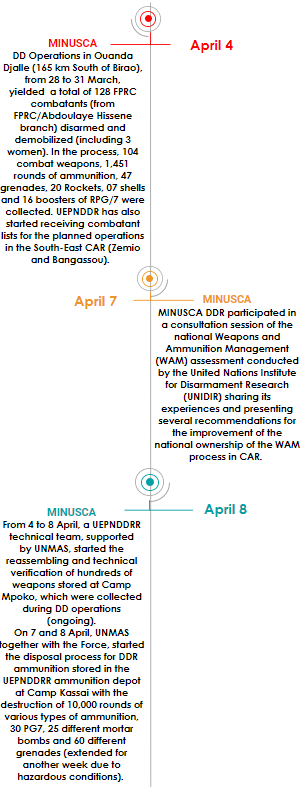
FIELD UPDATE HIGHLIGHTS
MONUSCO FOCUS – VISIT TO THE DEMOCRATIC REPUBLIC OF CONGO
Since 2004, the Democratic Republic of Congo (DRC) has had three Disarmament, Demobilization and Reintegration (DDR) programmes. A fourth iteration of the DDR programme was signed in an ordinance on the désarmement, démobilisation, relèvement communautaire et stabilization (P-DDRCS) by President Felix Tshisekedi on July 7, 2021, Shortly after he appointed the national coordinator of the P-DDRCS, Mr. Tommy Tambwe Ushindi, signalling a new phase in the DRC’s DDR focus and efforts.
With the dawn of a new DDR programme in the DRC, the DDR section in OROLSI travelled to the DRC from March 7 to 20, 2022 to better understand the situation on the ground as it pertains to DDR. During the visit, the team held various meetings with MONUSCO leadership, heads of offices, and sections, the P-DDRCS coordinator and deputy coordinator, donors, civil society, UN agencies, the Office of the Special Envoy for the Great Lakes (OSESG-GL); and international NGOs including Interpeace.
The visit also included field visits to the Armed Forces of the Democratic Republic of Congo (FARDC) North Kivu Mubambiro regroupment site near Goma, as well as to a CVR project in Shasha during which the team had the opportunity to interact with former combatants as well as children formerly associated with armed groups.
Contextual Analysis
Although the security situation in many parts of the country has improved, the eastern part of the DRC particularly, Ituri and North and South Kivu, is marred by persistent insecurity and continuous activities by armed groups, as well as defense and security forces. These three provinces are characterized by persistent human rights violations, abject poverty, absence of state authority and high levels of insecurity. In addition, there is widespread circulation and proliferation of weapons and ammunitions.
The armed group dynamics in the DRC are complex with a myriad of overlapping factors. These factors include long standing ethnic tensions in parts of the country, land conflict, and the perpetual illegal exploitation of natural resources, among others. Ranging between 70 to 140, armed groups vary in size and capacities. A handful of the groups have political objectives, and the vast majority are small groups stemming from within communities and act as self-defence groups. The conflict landscape in the DRC also includes a few foreign armed groups stemming from neighbouring countries and whose presence in eastern DRC is further enabled by porous borders, tensions with neighbouring countries, competition over natural resources in the east, among others.
In addition to the armed group dynamics, another element contributing to instability is that key national security forces, namely the FARDC and Congolese National (PNC), are overstretched, underpaid, under-capacitated, and inadequately prepared to ensure the extension of state authority necessary to provide security guarantees during the DDR programme. Interlocutors described widespread corruption and mismanagement of personnel and funds in both the FARDC and PNC. Additionally, according to Joint Human Rights Office reports, both the FARDC and PNC are among the top perpetuators of human rights violations including conflict-related sexual violence (CRSV).
While most combatants are men, many women take part in combat in the DRC. In the FARDC Mubambiro regoupment site, the team met with a few former combatants including women, some of whom claimed to have been commanders of battalions. The team also met young girls who were abducted by armed groups and were used as sex slaves. The gendered dimensions of conflict and armed groups are important to take note of, especially to ensure that the needs and conditions of women and girls are considered throughout the DDR process, and that women’s roles as peace agents are reinforced and amplified.
National DDR Programme
The DRC’s current DDR programme aims to learn from past mistakes and endeavours to follow three main principles: 1) DDR that is community focused; 2) no integration of armed elements into the security forces; and 3) no amnesty. These red lines have also been underscored by the international community as they are a welcome departure from past DDR programmes that heavily relied on a military approach.
From an organizational perspective, the P-DDRCS is characterized by two innovative approaches to DDR that are important to note. First, the P-DDRCS structure is situated within the presidency and thus it benefits from, and can leverage, the highest political support for its activities. Secondly, the convergence of stabilization and community reintegration under the P-DDRCS umbrella, in principle, provides the government an importunity to correct one of the major failings of past DDR programmes: the effective and durable long-term reintegration of ex-combatants and their dependents.
However, these approaches are not without their potential complications. A DDR approach which is embedded in an overall stabilization strategy requires joint planning and coordination across a wide range of workstreams, including line ministries, justice, as well as security sector reform. Coordination was therefore a critical running theme during the visit, both as it relates to internal collaboration within the government of DRC, but also and perhaps equally crucial, how the international community galvanizes itself around a common vision in support of the P-DDRCS. MONUSCO, agencies funds and programmes, and other line ministries have also established DDR-related coordination mechanisms. Altogether, the visit identified over 11 structures and mechanisms whose purposes is to coordinate issues around DDR.
To increase coordination and collaboration between the government, donor community and the UN, the team recommends that a single multi-stakeholder coordination platform be established (either creating a new, or adapting existing, mechanisms) bringing together the UN, donors, and the Government to address key political and strategic issues related to DDR. This body will also require a smaller, more nimble technical support team where operational bottle necks that emerge during implementation can be resolved jointly.
A gender-sensitive, youth-focused approach to the P-DDRCS is needed, and efforts should be made to ensure that women’s and youths’, particularly youth at risk, needs are considered throughout the process. Efforts should be made to explore the ways in which women can be part of the solution to sustainably bringing about peace and supporting efforts for former combatants to lay down their arms and ensure social cohesions upon return into their communities. Particular attention should also be paid to other specific groups including children, the elderly and former combatants with disabilities to ensure that tailored support can be provided to them.
GUEST FEATURE
“THE GAP BETWEEN KNOWLEDGE AND PRACTICE HAS TO BE BRIDGED”
An Interview with Augustine Owusu, DDR course Director at KAIPTC
The changing nature of conflict challenges the implementation of DDR mandates and leads to a continuous reengineering of DDR responses.
Capacity building through innovative training courses ensures the sharing of experiences and the transfer of state-of-the-art knowledge and provides DDR practitioners and key stakeholders with theoretical and practical tools, and thereby contributes to operational readiness on all levels and helps the Organization fulfill its mandates.
The Integrated Disarmament, Demobilization and Reintegration Training Group (IDDRTG) is composed of international organizations and training institutes with a common goal of developing and sharing training materials relating to the DDR-field. The IDDRTG develops trainings for DDR practitioners both from international and regional organizations, military, police and NGOs, as well as scholars and government officials, with the aim to provide an integrated approach to DDR with focus on planning, management and implementation of the process.
The current co-chair of the IDDRTG and as one of the three Peacekeeping Training Centres of Excellence mandated by the Economic Community of West African States (ECOWAS) to offer training in peacekeeping and Peace Support Operations (PSO) in Africa, the Kofi Annan International Peacekeeping Training Centre (KAIPTC) has a long tradition of offering DDR training courses.
The Editors of this Bulletin had a conversation with Augustine Owusu, DDR Course Director at KAIPTC, and talked about his personal DDR journey, the role of the IDDRTG co-chair, the uniqueness of DDR training courses at KAIPTC and about the future of DDR trainings.
Interview with Augustine Owusu, DDR Course Director at KAIPTC
“DDR
is continuously changing hence there is the need for constant DDR training“
CHILD REINTEGRATION IN ARMED CONFLICT SETTINGS
The Office of the Special Representative of the Secretary- General for Children and Armed Conflict
At least 8,521 children were recruited and used by parties to conflict in 21 different conflict situations in 2020, as verified by the UN (see the latest report of the UN Secretary-General on Children and Armed Conflict). But from the inception of the mandate of the Special Representative of the Secretary-General for Children and Armed Conflict (SRSGC CAAC), and through collaborative work with partners, including the United Nations Children’s Fund (UNICEF), the United Nations Department of Peace Operations, and the Department of Political and Peacebuilding Affairs, over 170 000 children have been released from armed forces or groups, with over 12,300 in 2020 alone.
The SRSG CAAC, since the creation of its mandate by the UN General Assembly resolution 51/77, has been serving as the leading UN advocate for the protection and well-being of children affected by armed conflict (see: “Study on the evolution of the Children and Armed Conflict mandate 1996-2021”). In the context of the release of children from armed groups and forces, Ms. Virginia Gamba, the SRSG CAAC, in her speech at the celebration of the 25th anniversary of the mandate earlier this year, stressed that securing sustainable reintegration of children back into their communities should be everyone’s priority and that “reintegration [is not only] a humanitarian and human rights imperative, it also is a strategic investment in sustainable peace and in the development of our societies”. At the same occasion, the UN Secretary General, Mr. António Guterres, in his video message urged to strengthen support to the release and the reintegration of children affected by conflicts.
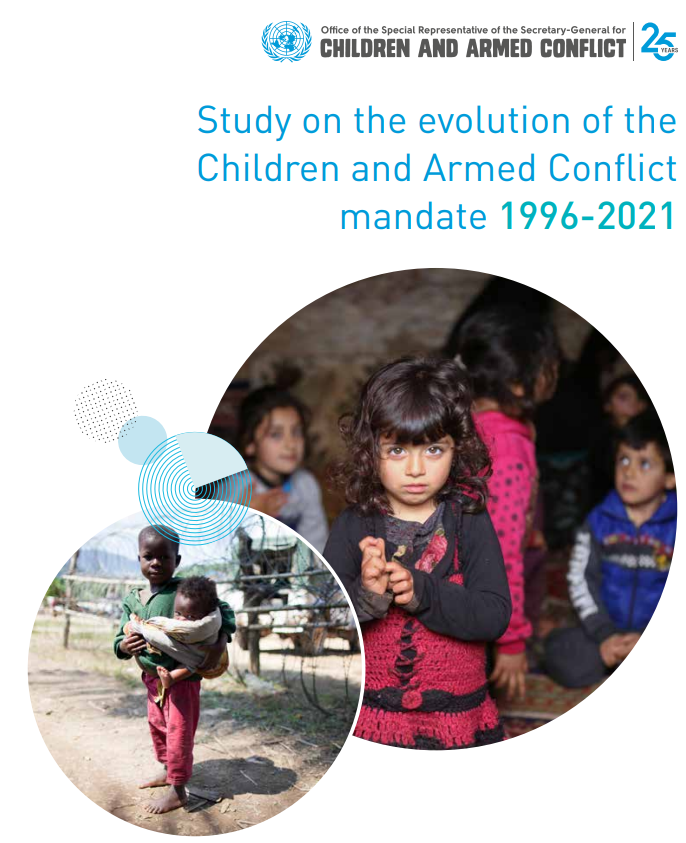
Reintegration of Children Released from Armed Forces and Groups
The provision of reintegration support for the children associated with armed forces and groups (CAAFAG) is an integral part of their release and is enshrined in the Convention on the Rights of the Child, CRC, (see CRC, Art. 37, 39, and 40). By endorsing the Paris Commitments to Protect Children from Unlawful Recruitment or Use by Armed Forces or Armed Groups, states committed to ensure that any funding for child protection is made available as early as possible, including in the absence of any formal peace process and formal DDR planning.
Community-based reintegration of children such as this one in Sudan, is a crucial prevention measure. It reduces the likelihood of re-recruitment; breaks the stigma of children affected by conflict and the vicious circles of violence; and contributes to the country’s development and peace and transition processes.
As defined in the revised version of the Integrated Disarmament, Demobilization and Reintegration Standards (IDDRS), Module 5.20, Children and DDR, child-centered reintegration is a multi-layered process which entails among others family reunification; mobilizing and enabling care systems in the community; medical screening and health care, including sexual and reproductive health services; schooling and/or vocational training; mental health and psychosocial support; and social, cultural, and economic support. This interconnectedness between reintegration, development, peace, and prevention, confirmed by the Principles and guidelines on CAAFAG, so called Paris Principles, is a good example of a broader Humanitarian-Development-Peace Nexus. Reintegration also contributes to the Youth, Peace and Security (YPS) and Women, Peace and Security (WPS) agendas as it redirects the potential of children and young people, with special focus on girls, in developing leadership and conflict resolution skills and taking responsibility for their actions including through meaningful participation. Guidance and standards included in the IDDRS, 5.20. Youth and DDR stress that the 15–24 age group should be particularity considered in the planning, design, and implementation of DDR assistance.
Children and Armed Conflict and Peace Processes
In 2018 the UN Security Council in its resolution 2427 stressed that in peace agreements a strong emphasis should be put on the best interest of the child, the treatment of children separated from armed groups as victims with a focus on family and community-based reintegration. The Council called to integrate adequate child protection provisions into all peace and ceasefire negotiations. The above-mentioned IDDRS also states that commitment to stop the recruitment of children and to release children from armed forces and groups should be stated within peace agreements. Examples of such inclusion in the past are, among others, the Colombian peace talks between the Government and the Revolutionary Armed Forces of Colombia – People’s Army (FARC-EP) concluded by the agreement on the separation and reintegration of children signed in Havana, Cuba in 2016 and the 1999 Lomé Peace Accord in Sierra Leone.
The Practical guidance for mediators to protect children in situations of armed conflict, published in 2020, also stresses that reintegration procedures for children should be “actively carried out at all times” and identifies them as a confidence-building measure.
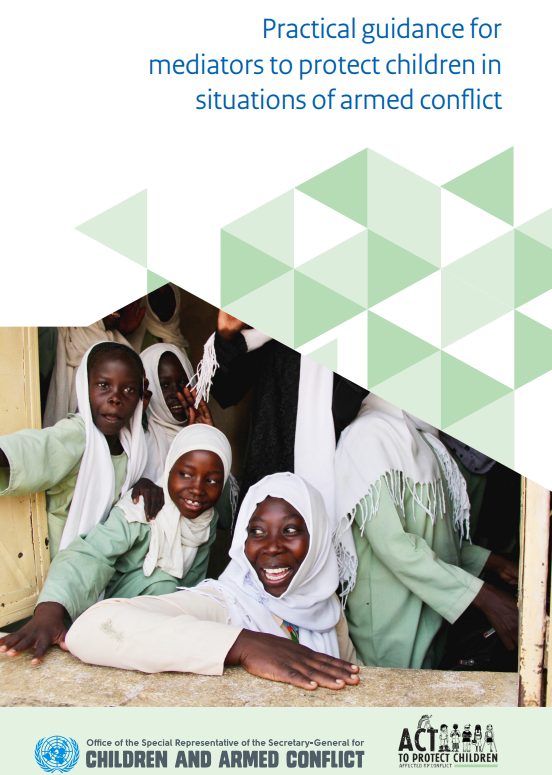
Reintegration in Protection of Children from Conflict
One important tool of the CAAC agenda is creation of action plans that parties to conflict listed in the annexes of the SG’s annual report on CAAC sign with the UN to address grave violations against children. One of the commitments included in the action plans is to facilitate the release of children and provide reintegration support to them. There are currently 19 action plans under implementation with the two most recent ones signed in Mali in August 2021. Another tool to foster the protection of children is handover protocols. They are standard operating procedures (SOP) signed typically between the UN and the governments (e.g., Chad, Mali, Niger, Somalia, Sudan, and Uganda) and their implementation is supported by the UN. The objective of such protocols is to swiftly transfer children allegedly associated with armed groups to civilian child protection agencies for reintegration. Additionally, there are instances in which a non-state armed group can sign a similar SOP for the handover of children, as it was in Yemen.
Engagement of the International Community for the Reintegration of Children
Regional organizations have also an important role to play in mainstreaming child reintegration standards and creating sustainable frameworks. For example, the members of the International Conference on the Great Lakes Region committed to “take all necessary measures to ensure that former child soldiers are exempted from compulsory military service, [are] reunited with their families, reintegrated into their communities, rehabilitated, counselled, and resettled”.
The COVID-19 pandemic has exacerbated challenges for child reintegration and endangers the local and national funding of the reintegration programs (see CAAC publication: Impact of the COVID-19 pandemic on violations against children in situations of armed conflict). Therefore, even greater emphasis should be put on promoting child reintegration as the shared responsibility of multiple stakeholders to support children and invest in long-term resilience and stability.
Reintegration-related advocacy on the international level has advanced since the creation of the Global Coalition for Reintegration of Child Soldiers (GCR) in 2018. The Coalition is co-chaired by the Office of the SRSG CAAC and UNICEF and comprises UN agencies; Member States; NGOs; the World Bank; and academics. Member States can also join the Friends of Reintegration group, creating momentum to foster cooperation and to contribute to the coordination of joint efforts. The year 2022 marks 25 years since the creation of the children and armed conflict mandate and comprises other important anniversaries: 20 years since the entry into force of the Optional Protocol to the CRC on the Involvement of Children in Armed Conflict and 15 years since the adoption of the Paris Principles. Children should always be put at the heart of the implementation of these commitments and the best interest of the child should guide the efforts of the international community towards sustainable peace and development.

IDDRS Updates
The work on the Integrated Disarmament Standards (IDDRS) has continued. The modules in level three focus on practical guidance for the planning, design, and assessment of DDR programmes, including such pertinent questions as budgeting, staffing and the relation with national institutions. They, therefore, have a significant concrete impact on the work of DDR practitioners in the field, and their validation is highly anticipated.
The IDDRS are a comprehensive and detailed set of policies, guidelines and procedures for undertaking DDR. They cover over 30 thematic areas within DDR, ranging from planning, design, monitoring and evaluation through the protection of specific needs groups, such as children, youth and women and mainstreaming of cross-cutting issues, such as health, HIV/AIDS, gender and youth, to linkages with other processes, such as security sector reform (SSR) or transitional justice (TJ). The IDDRS are a repository of lessons and best practices drawn from the experience of all UN entities involved in supporting DDR and are always the subject of broad consultation before becoming accepted as guidance.
IDDRS Modules Status
IN PROGRESS
TO BE VALIDATED
COMPLETED
level 1
General IDDRS
module1.10
Introduction to the IDDRS
module1.10
Glossary: Terms and Definitions
level 2
Concepts, Policy and Strategy of the IDDRS
module2.10
The UN Approach to DDR
module2.11
The Legal Framework for UN DDR
module2.20
The Politics of DDR
module2.30
Community Violence Reduction
module2.40
Reintegration as Part of Sustaining Peace
level 3
Structures and Processes
module3.10
Integrated DDR Planning: Processes and Structures
module3.11
Integrated Assessments
module3.20
DDR Programme Design
module3.21
Participants, Beneficiaries, and Partners
module3.30
National Institutions for DDR
module3.40
Mission and Programme Support for DDR
module3.41
Finance and Budgeting
module3.42
Personnel and Staffing
module3.50
Monitoring and Evaluation
level 4
Operations, Programmes and Support
module4.10
Disarmament
module4.11
Transitional Weapons and Ammunition Management
module4.20
Demobilization
module4.30
Reintegration
module4.40
UN Military Roles and Responsibilities
module4.50
UN Police Roles and Responsibilities
module4.60
Public Information and Strategic Communication in Support of DDR
level 5
Cross-cutting Issues
module5.10
Women, Gender and DDR
module5.20
Children and DDR
module5.30
Youth and DDR
module5.40
Cross-border Population Movements
module5.50
Food Assistance in DDR
module5.60
HIV/AIDS and DDR
module5.70
Health and DDR
module5.80
Disabilities and DDR
level 6
Linkages
module6.10
DDR and SSR
module6.20
DDR and Transitional Justice
module6.30
DDR and Natural Resources
module6.40
DDR and Organized Crime
module6.50
DDR and Armed Groups Designated as Terrorist Organisations
module6.50
DDR and Armed Groups Designated as Terrorist Organisations
PUBLICATIONS / GUIDANCE / REPORTS
MOST RECENT
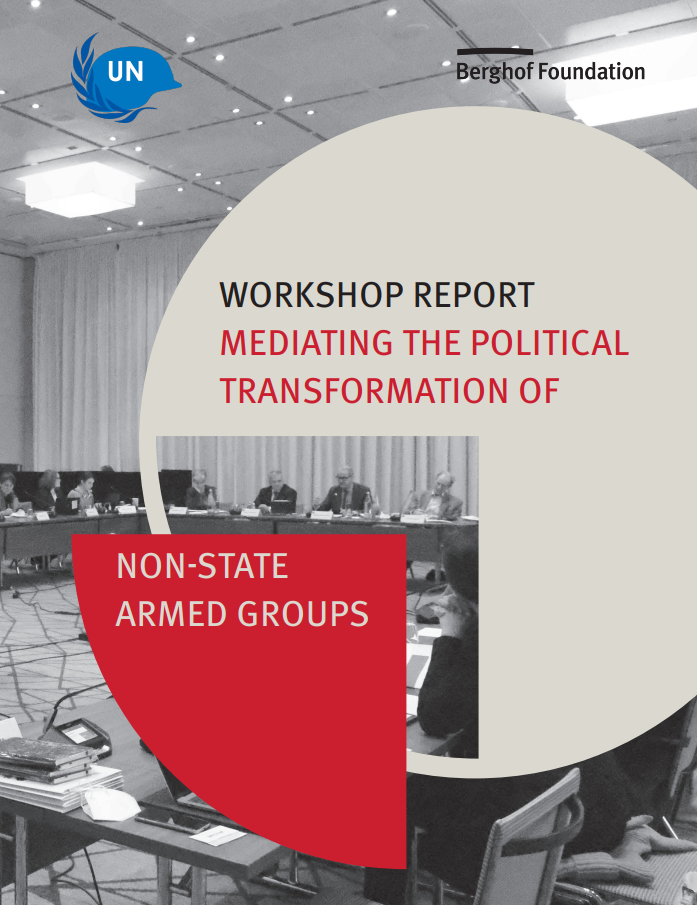
Workshop Report: Mediating Political Transformation of Non-State Armed Groups
On December 7, 2021, the Berghof Foundation and UN DPO Disarmament, Demobilization and Reintegration (DDR) Section jointly conducted an expert workshop on the topic of ‘mediating political reintegration’. In this workshop, selected experts and practitioners from the political transformation, DDR, and mediation fields exchanged ideas about past approaches, lessons learned, and future possibilities for the successful political transformation of non-state armed groups (NSAGs) as part of mediated peace processes. The workshop constitutes a contribution to the operationalization of the Integrated DDR Standards (IDDRS) module 2.20 “Politics of DDR.” This workshop report summarizes the content and outcomes of these discussions.
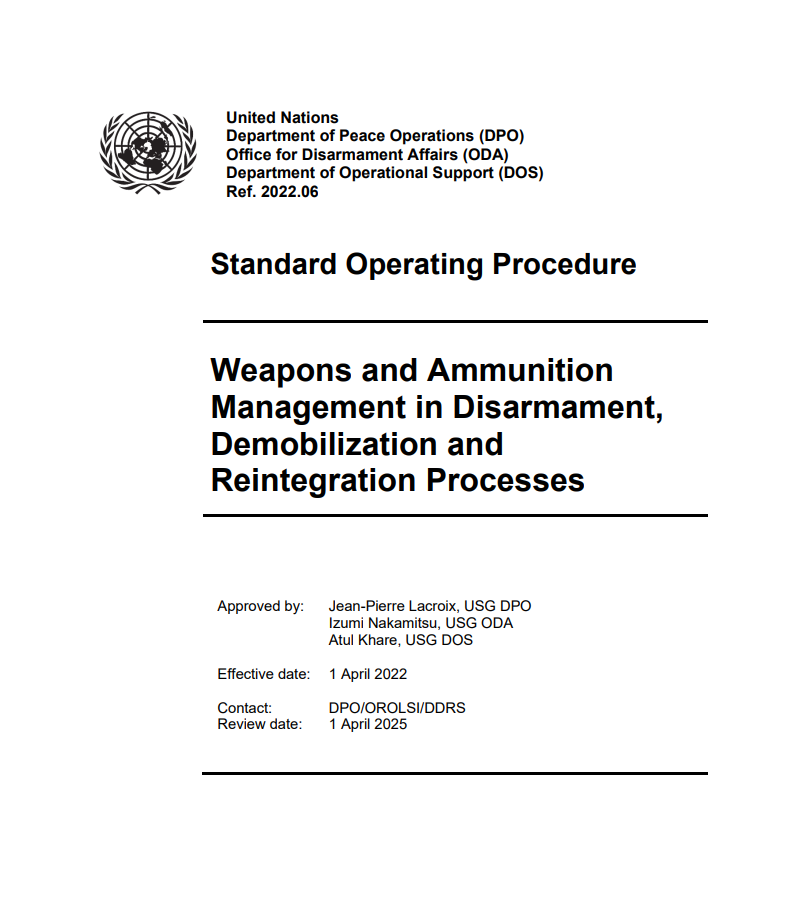
Standard Operating Procedure: Weapons and Ammunition Management in Disarmament, Demobilization and Reintegration Process
Illicit weapons and ammunition flows fuel conflict and hamper efforts for peace and stability. Disarmament of combatants and transitional weapons and ammunition management (WAM) activities are key components of disarmament, demobilization and reintegration (DDR) processes. Ensuing that weapons and ammunition collected during these activities do not pose a risk to civilians or United Nations personnel – ranging from explosive risks to the threat of repurposing or diversion – is paramount. Thus, a Standard Operating Procedure (SOP) on WAM in DDR Processes has therefore been developed as a result of collaboration between the Department of Peace Operations, the Office for Disarmament Affairs, and the Department of Operational Support. Based on international standards and guidelines, the SOP aims to support mission personnel in implementing efficient, safe, and secure disarmament operations and transitional WAM activities as part of integrated DDR processes. It will act as a global-level blueprint for the development or enhancement of mission-specific SOPs, providing guidance on collection, handling, storage, transportation and disposal of weapons and ammunition in the context of DDR.
OTHER PUBLICATIONS
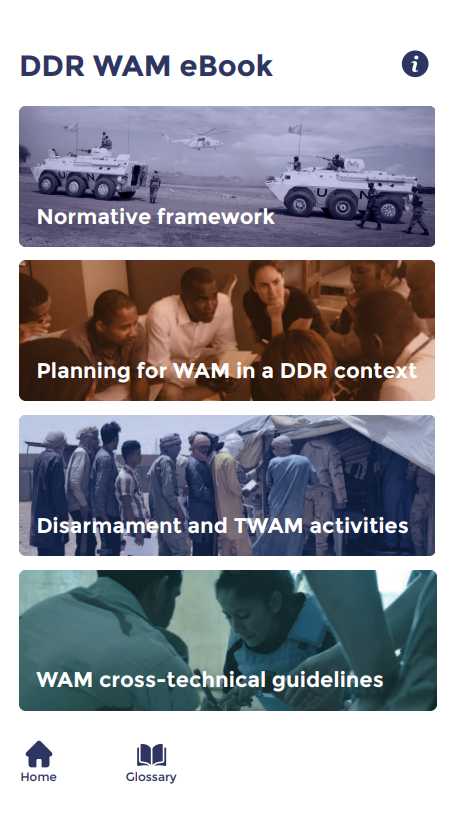
DDR WAM eBook
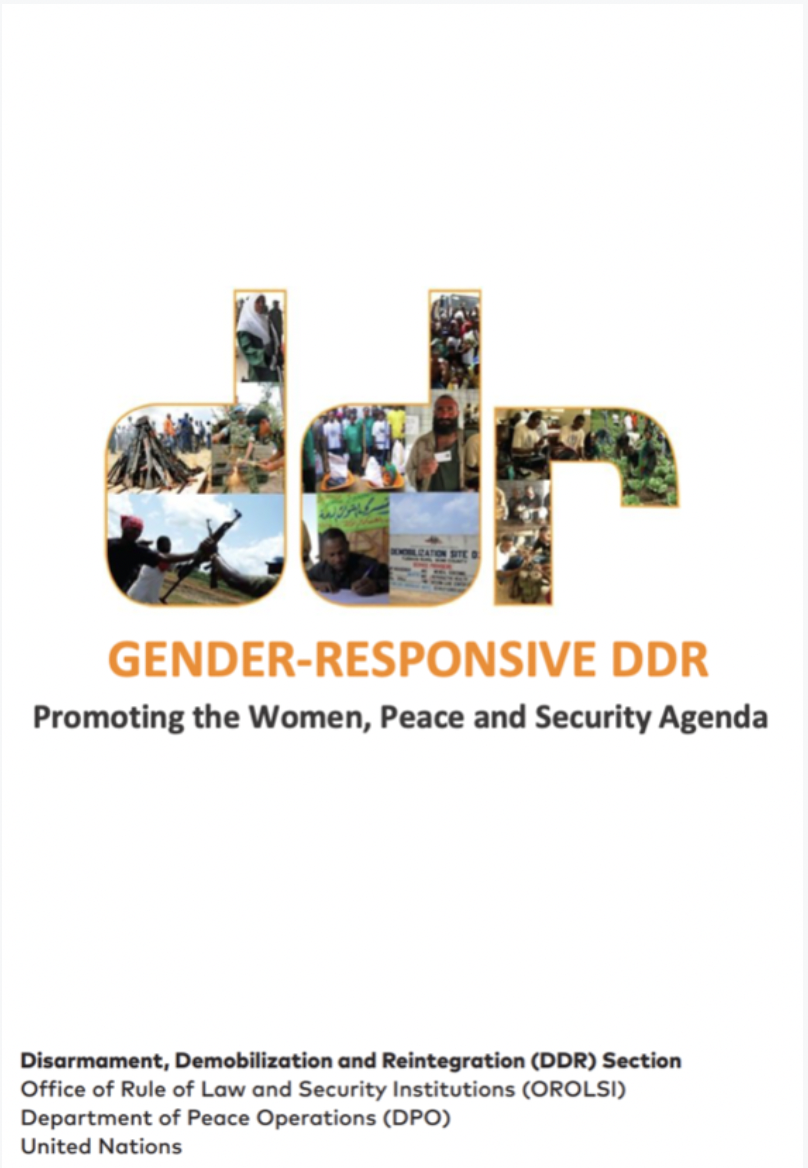
Gender-Responsive DDR
Promoting the Women, Peace and Security Agenda
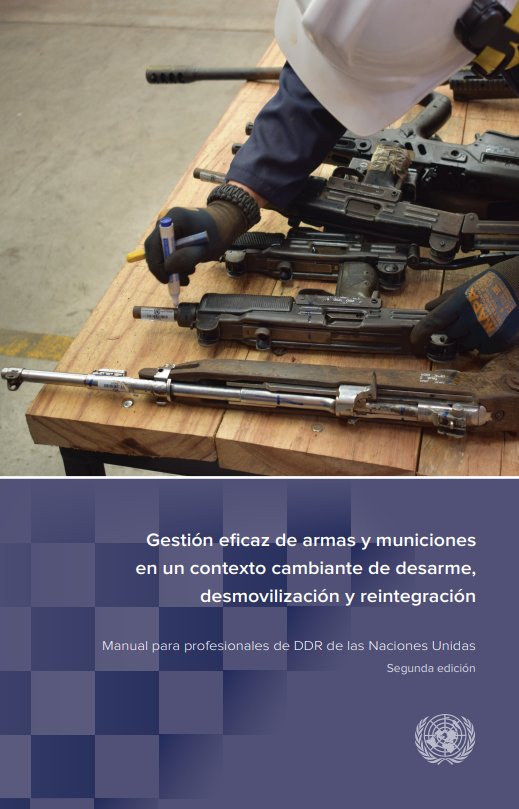
Handbook for United Nations DDR Practitioners
Effective Weapons and Ammunition Management in a Changing Disarmament, Demobilization, and Reintegration (DDR) context
Upcoming
EVENTS
Launch Event for Phase two of the Typology Project (sound-boarding workshop)
Format: In person, Sweden House (New York)
Date: 25 May 2022
Stockholm Peace Forum
Format: In person
Date: 23 – 25 May 2022
Political Transformation of Armed Groups
Format: In person, Secretariat-Conference room 3 (New York)
Date: 20 June 2022
Second Annual DDR Symposium and Meeting of Senior DDR officers in UN peace operations
Format: In person, Secretariat Conference Room 3 (New York)
Date: 21 – 24 June 2022
Integrated DDR Training Group (IDDRTG) Annual General Meeting
Format: In person, Bogota (Colombia)
Date: 11 – 16 July 2022
Training Opportunities
Regular training opportunities are vital to ensure that staff are equipped with the skills and knowledge to address ever-changing challenges effectively. Upcoming opportunities include:
Advanced Stabilization and Reintegration Course
Organizer: Kofi Annan International Peacekeeping Training Centre (KAIPTC)
Format: In person, Accra (Ghana)
Date: 06 – 17 June 2022
Link: Advance Stabilisation and Reintegration Course 2022 (DDRF22-2) – KAIPTC
Advanced (Re)integration Training Course
Organizer: Transition International (TI) and Barcelona International Peace Centre (BIPC)
Format: In person, Barcelona (Spain)
Date: 10 – 16 July 2022
Link: (RE)INTEGRATION ADVANCED TRAINING COURSE – Barcelona International Peace Center (bcnpeacecenter.org)
Community Violence and Reduction (CVR) Workshop
Organizer: Department of Peace Operations (DPO), United Nations Institute for Training and Research (UNITAR)
Format: In person, Stans (Switzerland)
Date: 18 – 22 July 2022
Effective WAM in a changing DDR context Training Course
Organizer: Department Of Peace Operations (DPO), Office of Disarmament Affairs (ODA), United Nations Institute for Training and Research (UNITAR)
Format: In person, Accra (Ghana)
Date: November/ December 2022 (TBC)
